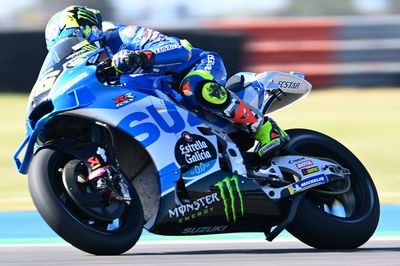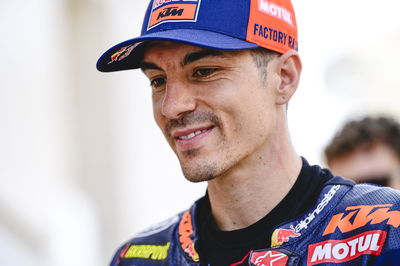Exclusive: Front ride-height ban ‘correct thing to do’ - rear next?
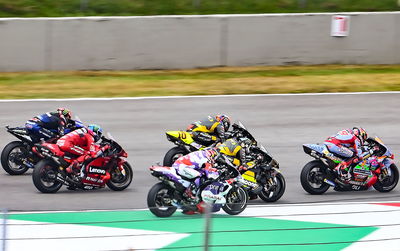
Rear ride-height devices, which unlike the front are already used throughout the MotoGP grid, remain legal.
However, it looks to be a case of when, not if, they will also be prohibited.
“It is our intention to ask the manufacturers to consider banning the rear as well, given a proper timeframe,” MotoGP Director of Technology Corrado Cecchinelli told Crash.net.
- ‘Danger zone’: MotoGP’s new accident detection system explained
- Cancelled laps for breaching MotoGP tyre pressures in 2023
- Triumph: Electric power? ‘Let’s not kid ourselves...’
Ducati caught the MotoGP world off-guard with its original rear ride-height system, which began as a ‘holeshot’ starting aid in late 2018 before evolving into repeatable use for corner exit from Buriram 2019.
Realising the front would follow, increasing acceleration performance further, Dorna tabled a proposal to the MSMA (manufacturers association) to maintain the status quo. In other words, front and rear holeshot devices for the start, but only the rear thereafter.
“We proposed [to ban] just the front because nobody had used such a system during races at the time of our proposal, so we believed it was a good time for a preventative action which was basically going to leave things as they were, whereas the rear was and is commonplace, so banning it was going to be a big deal for everybody,” Cecchinelli said.
But during the subsequent discussions within the MSMA, it became clear that Ducati was already on the verge of racing with a front ride-height system.
Cecchinelli said Dorna was then prepared to withdraw its proposal, but most manufacturers remained keen on a ban which - according to Ducati - was then voted through by 5 out of the 6 factories inside the MSMA.
“[The front ride-height proposal] came from our side. Then there was a big fight [about it within the MSMA] so we were ready to withdraw the proposal. But a big majority of the manufacturers were still in favour of banning it and kept pushing for it, so in the end it was voted through,” Cecchinelli confirmed.
“We still believe it is, in principle from the technical perspective, the correct thing to do because it's an effective way to control performance. But still we don’t like, in general, changes that are not unanimously agreed.”
While the front ride-height ban was passed before last year's Qatar season-opener, in order to give Ducati the opportunity to benefit from the work it had already done, the system remained legal until the end of 2022.
The Pramac team of Johann Zarco and Jorge Martin initially continued to develop the device during race weekends. However, the advantages were less clear than the rear, also because the resulting change in bike set-up and front feeling put them at odds with the other Desmosedicis.
Zarco persisted, but the looming ban meant the potential gain diminished with each race weekend and he focussed on the standard fork by the Valencia finale.
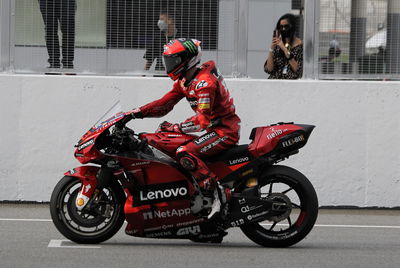
‘There will always be new discoveries'
Cecchinelli underlined that technical rule amendments, including closing unexpected loopholes, are a constant and normal process.
“This is always an issue. Because the manufacturers are smarter than us and have many more people working for them, it’s not possible by definition to write technical regulations that will cover every area, perfectly, forever,” he said.
“There will always be new discoveries in the future that you were not thinking about at the time, also because the whole world is constantly moving and changing. So I really don't understand any issues with changing or updating the regulations. It's normal. It’s a continuous job. It's not a job you do once and then it lasts forever.”
While some teams had previously dabbled in holeshot devices, MotoGP’s ban on the use of electronically controlled suspension kept full ride-height devices at bay until Ducati surprised its rivals by creating a system using only mechanical and hydraulic parts.
For rule makers, the tricky question then becomes if, when and how to close such a legal loophole without penalising the original manufacturer - through ‘wasted’ development work - just for being cleverer than its rivals.
“There's always the question of being fair to those who invent something you weren’t expecting and giving them a correct reward for having been better than the others. But you have to balance that with the fact you didn't really want what they are doing, to be done,” Cecchinelli said.
“We try to find a compromise but sometimes in doing our job, we will make someone angry. That's racing. We have the very clear principle of being fair to those who find something which is allowed. But on the other hand, it’s allowed because you didn't think about it at the time of writing the rules, or because something new wasn’t in existence at the time and then comes out, not because you wanted it.”
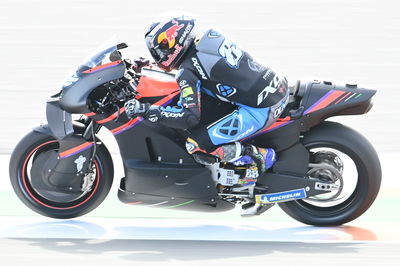
Rear ride-height ban by 2027?
In justifying their decision to vote for the front ride-height ban, the main reason cited by the technical heads of Yamaha, Honda, Aprilia, KTM and Suzuki was a lack of road bike relevance.
That’s because anyone that wanted to fit a ride-height device to a road bike (for example to lower the rear under hard braking to resist the ‘stoppie’ effect) would simply use an electronically controlled system.
Then again, the current breed of seamless shift gearboxes, debuted by Honda in 2011, were designed around MotoGP’s ban on Continuously Variable Transmission systems (CVT) and, like carbon brakes and slick tyres, are unlikely to ever see road use.
HRC’s Takeo Yokoyama highlighted that, while the seamless gearbox itself may not have road relevance, Honda has learned a lot of transferable technology from the control systems needed to operate it.
A similar argument could be made for keeping mechanical ride-height devices but the strength of opposition seems much higher, not least due to concerns they are spoiling the show.
But even if the clock is ticking, it could take until the end of 2026 - the expiry date for the current MotoGP contract between Dorna and the manufacturers - for a ban to be introduced, unless there is unanimous agreement.
Asked if there was a time frame in mind to ban the rear device, Cecchinelli replied:
“We don’t want to think about any major changes or big revolution until 2027, so we are moving in small incremental steps until then, unless everybody agrees, as for example happened with ‘sustainable’ fuels.
“But the sooner we can agree with the manufacturers about the 2027 package the better, because you can make bigger changes if the manufacturers have enough time to prepare for them.
“For example, no-one would agree to change the engine size for 2027 in 2026!”
40% non-fossil fuels will be introduced in all grand prix classes from 2024, rising to 100% from 2027.
